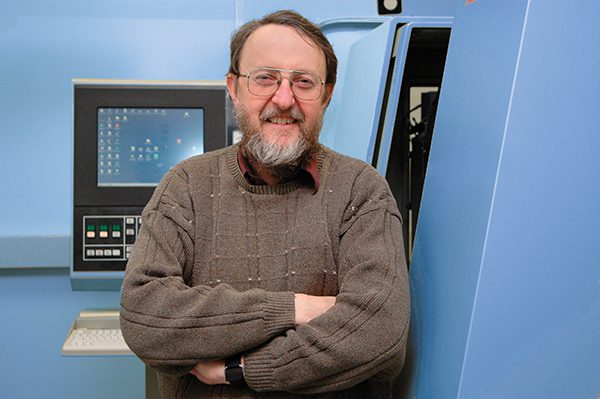Chris Evans Named New Director of Center for Precision Metrology

Dr. Chris Evans has been named the new director of the Center for Precision Metrology at the University of North Carolina at Charlotte, taking over for Dr. Bob Hocken who retired in June 2014.
One of the world’s most prominent researchers in the field of precision measurement, Dr. Evans joined The William States Lee College of Engineering at UNC Charlotte in 2011. Since that time his research focus has been in advanced metrology and precision diamond-turned optics surface techniques.
During the past 30 years, Dr. Evans was a research colleague of Dr. Hocken on several occasions. In 1985, Dr. Evans left his homeland of England to come to the United States and work for Dr. Hocken at the National Bureau of Standards, now the National Institute of Standards and Technology. During his career at NIST, Dr. Evans worked in optics manufacturing, optical metrology and precision machining. He created and built up the Manufacturing Process Metrology Group within NIST’s Manufacturing Engineering Laboratory.
One of Dr. Evans’ most memorable projects while at NIST was the hermetic encasements for the Charters of Freedom documents at the National Archives in Washington D.C. The Charters of Freedom are the Declaration of Independence, Constitution and Bill of Rights. He lead the team that built a light-weight, passive system (no pumps) that would encase the documents in argon gas and a small amount of helium, all kept at 50 percent relative humidity. It was designed so that it would not let in more than two percent oxygen in 100 years.
In 2001, Dr. Evans went to work for Zygo Corp. in Middlefield, Connecticut, as a senior research scientist and the chief metrologist in its research and development group. His work at Zygo focused mainly on optical metrology, both for use in optics manufacturing and in highly specialized custom instruments.
Dr. Evans was also involved in the metrology of the Laser Interferometer Gravitational-wave Observatory (LIGO), one of the major projects in the United States requiring very high quality optics. The purpose of the LIGO is to measure gravitational waves (ripples in space-time) resulting from massive cosmological events. Dr. Evans’ group at NIST devised and implemented a metrology system to measure prototype optics from vendors vying for the observatory contract, showing that 250 mm aperture optics with radii of curvature in the range of 6 to 11 km could be measured with sub nm uncertainties.
After 25 years, Dr. Evans returned to working with Dr. Hocken, this time at UNC Charlotte. His research at Charlotte has included optical metrology and optics fabrication including diamond turning. His laboratory includes a Magneto-Rheological Finishing Machine (MRF) to do fine optics polishing. He also researches the long-term chemical wear of diamond tools.
Education:
- Ph.D. in Mechanical Engineering from the University of Birmingham, England, 1996.
- M.Sc. in Precision Engineering from Cranfield Institute of Technology, England, 1987.
- B.Sc. (Hons) in Chemical Engineering, University of Manchester Institute of Science and Technology, 1975.
Professional Affiliations
- Fellow of CIRP (College International pour la Recherche en Productique), the International Academy of Production Research
- Charter member and honorary member, American Society for Precision Engineering, and awarded a Lifetime Achievement Award in 2010
- Member Optical Society of America
- Member Society of Photo-Optical Instrumentation Engineers (SPIE)